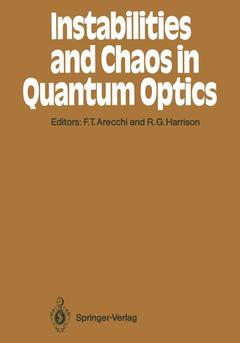Description
Instabilities and Chaos in Quantum Optics, Softcover reprint of the original 1st ed. 1987
Springer Series in Synergetics Series, Vol. 34
Coordinators: Arecchi F.Tito, Harrison Robert G.
Language: English
Subject for Instabilities and Chaos in Quantum Optics:
Keywords
Publication date: 11-2011
254 p. · 17x24.4 cm · Paperback
254 p. · 17x24.4 cm · Paperback
Description
/li>Contents
/li>
Of the variety of nonlinear dynamical systems that exhibit deterministic chaos optical systems both lasers and passive devices provide nearly ideal systems for quantitative investigation due to their simplicity both in construction and in the mathematics that describes them. In view of their growing technical application the understanding, control and possible exploitation of sources of instability in these systems has considerable practical importance. The aim of this volume is to provide a comprehensive coverage of the current understanding of optical instabilities through a series of reviews by leading researchers in the field. The book comprises nine chapters, five on active (laser) systems and four on passive optically bistable systems. Instabilities and chaos in single- (and multi-) mode lasers with homogeneously and broadened gain media are presented and the influence of an injected signal, loss modulation and also feedback of laser output on this behaviour is treated. Both electrically excited and optically pumped gas lasers are considered, and an analysis of dynamical instabilities in the emission from free electron lasers are presented. Instabilities in passive optically bistable systems include a detailed analysis of the global bifurcations and chaos in which transverse effects are accounted for. Experimental verification of degenerative pulsations and chaos in intrinsic bistable systems is described for various optical feedback systems in which atomic and molecular gases and semiconductors are used as the nonlinear media. Results for a hybrid bistable optical system are significant in providing an important test of current understanding of the dynamical behaviour of passive bistable systems.
1. Introduction.- 1.1 A Heuristic Approach to Instabilities.- 1.2 About This Book.- References.- I Instabilities and Chaos in Active Systems.- 2. Instabilities and Chaos in Single-Mode Homogeneous Line Lasers.- 2.1 Background.- 2.2 Transient Decay Toward a Stable State.- 2.3 Deterministic Chaos.- 2.3.1 Historical Aspects.- 2.3.2 Dynamical Aspects.- 2.3.3 Information Aspects.- 2.3.4 Role of Transients: The Hyperchaos.- 2.4 The Modulated Laser.- 2.5 The Laser with Injected Signal (LIS).- 2.6 Instabilities in a Laser with Feedback.- 2.7 The Bidirectional Ring Laser.- 2.8 Conclusion.- 2.A Appendix: A Simple-Minded Approach to Laser Equations.- 2.A.1 The Laser Equations.- 2.A.2 Adiabatic Elimination of Polarization - Modulation and Injection.- 2.A.3 Linear Stability Analysis of Class B Solutions.- 2.A.4 Laser with Injected Signal (LIS).- 2.A.5 The Bidirectional Class B Ring Laser.- References.- 3. Experimental Measurements of Transitions to Pulsations and Chaos in a Single Mode, Unidirectional Ring Laser with an Inhomogeneously-Broadened Medium.- 3.1 Background.- 3.2 The Single-Mode, Inhomogeneously-Broadened, Unidirectional Ring Laser.- 3.2.1 Background.- 3.2.2 Experimental Set-Up.- 3.2.3 Thresholds for Transitions from Stable to Pulsed Behavior.- 3.2.4 Changes in the Pulsation Pattern Above the Second Threshold.- 3.2.5 Confirming and Characterizing the Chaos.- 3.3 Discussion.- References.- 4. Single- and Multi-Mode Operation of a Laser with an Injected Signal.- 4.1 Background Information.- 4.2 Equations of Motion and the Steady-State Configuration.- 4.3 Linear Stability Analysis in the Mean-Field Limit.- 4.4 Adiabatic Elimination of the Atomic Variables.- 4.5 Dynamical Behavior of the Single-Mode Model.- 4.6 Power Spectra and Lyapunov Exponents.- 4.A Appendix: Derivation of (4.14).- 4.B Appendix: List of the Coefficients of (4.29).- 4.C Appendix: List of Coefficients in (4.31).- References.- 5. Experimental Observations of Single Mode Laser Instabilities in Optically Pumped Molecular Lasers.- 5.1 Background.- 5.2 Optically Pumped Far Infrared Lasers.- 5.2.1 Resonant Pumping.- 5.2.2 Detuned Pumping.- 5.2.3 Single-Mode Laser Instability in Near Resonantly Pumped Mid-Infrared Systems.- 5.3 Conclusion.- References.- 6. Quantum Treatment of Amplified Spontaneous Emission in High-Gain Free-Electron Lasers.- 6.1 Introduction.- 6.2 The Quantum Hamiltonian Model.- 6.3 Classical Limit and Classical Treatment of Amplified Spontaneous Emission.- 6.4 The Basic Equations of the Linear Quantum Regime.- 6.5 Analysis on Resonance and for Sufficiently Long Times.- 6.6 “Harmonic Oscillator” Limit.- 6.7 “Classical” Limit.- 6. A Appendix.- References.- Additional References with Titles.- II Instabilities and Chaos in Passive Systems.- 7. Global Bifurcations and Turbulence in a Passive Optical Resonator.- 7.1 Background Material.- 7.2 Model and Theory.- 7.3 Bifurcation and Global Phase Portraits.- 7.4 The Plane-Wave Map.- 7.4.1 The Newhouse Sink Phenomena.- 7.4.2 Boundary Crisis.- 7.5 Gaussian Beams (2D Problem).- 7.5.1 Stability of the Plane-Wave Map to Transverse Spatial Perturbations.- 7.5.2 Solitary Waves as Fixed Points of the Infinite Dimensional Map.- 7.5.3 Many Routes to Optical Turbulence.- 7.6 Gaussian Beams (3D Problem).- 7.7 Summary.- References.- 8. Experimental Verification of Regenerative Pulsations and Chaos.- 8.1 Regenerative Pulsations.- 8.2 Ikeda Instabilities.- 8.2.1 Experimental Setup.- 8.2.2 Review of Period Doubling.- 8.2.3 Universality.- 8.2.4 Nature of Transitions.- 8.2.5 Effects of Noise.- 8.2.6 Other Waveforms/Alternate Paths.- 8.2.7 Test for Chaos in High-Speed Optical Systems.- 8.3 Instabilities in Sodium Vapor.- 8.3.1 Optically Thick.- 8.3.2 Optically Thin.- 8.4 Issues for Fast Chaotic Systems.- References.- 9. Instabilities and Routes to Chaos in Passive All-Optical Resonators Containing Molecular Gases.- 9.1 Background.- 9.2 Theory of Instabilities in Passive Nonlinear Resonators.- 9.2.1 The Basic Model.- 9.2.2 Physical Interpretation of the Ikeda Instability.- 9.2.3 Fabry-Perot Resonators.- 9.2.4 Universality.- 9.2.5 Trapping Bifurcation Points.- 9.3 Nonlinear Absorption Characteristics of Molecules.- 9.3.1 Ammonia.- 9.3.2 Sulphur Hexafluoride.- 9.3.3 Molecular Energy-Level Scheme.- 9.4 Optical Bistability and Instability Generation in Optical Resonators.- 9.4.1 Ring Resonator.- 9.4.2 Fabry-Perot Resonator.- 9.4.3 Fabry-Perot Resonator with Sulphur Hexafluoride.- 9.5 Conclusion.- References.- 10. Transmission Properties of a Sodium-Filled Fabry-Perot Resonator.- 10.1 Background.- 10.2 Experimental Set-Up.- 10.3 Discussion.- 10.3.1 Optical Bistability by Zeeman Pumping.- 10.3.2 Optical Tristability.- 10.3.3 Multistability.- 10.3.4 Self-Pulsing.- References.
© 2024 LAVOISIER S.A.S.
These books may interest you

Nonlinear Optical Systems 88.33 €



